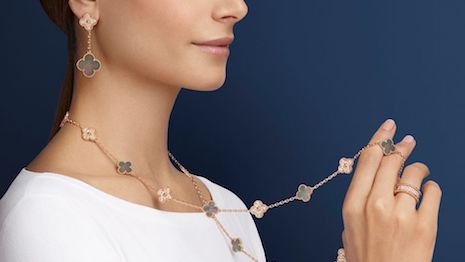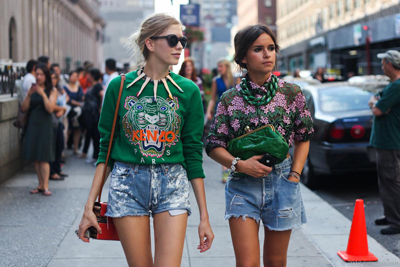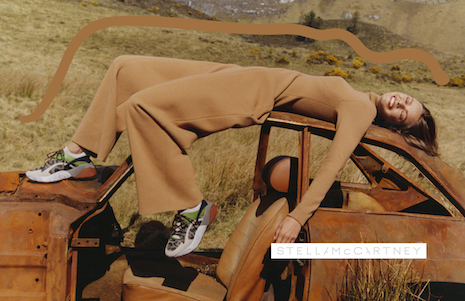 Van Cleef & Arpels' Alhambra is particularly popular on The RealReal. Image credit: Van Cleef & Arpels
Van Cleef & Arpels' Alhambra is particularly popular on The RealReal. Image credit: Van Cleef & Arpels
Over the last decade, Supreme beat out luxury labels to represent the best return on investment among fashion brands in the secondhand market, pointing to the retail impact of the rise of streetwear in the 2010s. According to new data from The RealReal, along with streetwear, maximalism was a top trend during the last 10 years, driven by designers including Gucci’s Alessandro Michele. Between the rise of millennials and the growing awareness of fashion’s environmental impact, resale has been on the rise as consumers are embracing styles from the past. "The advent of eBay brought the concept of resale from neighborhood consignment shop to online marketplace and accessible to the masses," said Sasha Skoda head of women's at The RealReal. "While there was a clear appetite for peer-to-peer resale, there was also a big opportunity to evolve, remove friction and ultimately unlock even more trapped value in peoples homes, and that included luxury goods. "By taking possession of all items and handling the entire process for the consumer – authenticating, merchandising, photographing and shipping – we established newfound trust and ease that I think helped set a real precedent in resale," she said. "People also saw that resale could be synonymous with luxury – that we were preserving the beauty, integrity and luxe of the brands." Trend waves Following Supreme, Goyard, Van Cleef & Arpels, Hermès and Louis Vuitton rounded out the top five brands with the best resale value during the decade. Logos helped to drive almost a 200 percent greater resale value for products, with Dior, Gucci, Hermès and Chanel some of the most impactful logos. Meanwhile, Gucci, Fendi and Dior saw the greatest gains in resale value during the last decade. Gucci was among the labels that saw an impact in resale value due to a creative director change. After Alessandro Michele joined, Gucci’s resale grew 1.7 times stronger. Other brands have seen even more significant benefits due to a change in creative director. For instance, Dior Men’s Kim Jones has raised secondhand values for his brand by 5.2 percent, while Bottega Veneta’s hire of Daniel Lee boosted resale values by 4 times.
Instagram post from Bottega Veneta This effect is also being seen for new merchandise. According to data from Lyst, Bottega Veneta has seen a surge of consumer interest under its new creative direction, and this past quarter the house has risen to become one of the top 20 buzziest brands. For the first time in the two-year history of the Lyst Index, Bottega Veneta made the cut and placed 16th, climbing 21 places in a matter of months. The brand’s breakout during the third quarter was thanks to a combination of new creative direction, influencer awareness and social media conversation (see story). "Gucci and Dior saw spikes in resale value with the introduction of new creative directors – Alessandro Michele and Kim Jones respectively – both injecting fresh points of view that particularly resonate with millennials," Ms. Skoda said. "It's not just Gucci and Dior addressing the younger demographic, Fendi is as well. "I think each brand really understands the shift happening among luxury shoppers and that it's increasingly skewing younger," she said. "As such, they're releasing unique and bold collections that deliver that individuality the Gen Z and millennial generations seek. "We're also seeing strong demand for nostalgia – the 90s specifically. That said, the rerelease of the Dior Saddle bag and Fendi Baguette helped drive overall resale for both brands." Social media has changed how fashion purchases are influenced, particularly among contemporary labels. The RealReal crunched the resale values to identify the contemporary brands with the top resale value in each year, and found that each year had different winners. Whereas designers such as Kate Spade and Alexander Wang were popular in the early 2010s when retailers were the influencers, today’s consumers are responding more to social media-favorite labels such as Ganni and Jacquemus. Some of the standout items from the decade included the Valentino Rockstud pumps that were popular in 2012, the Kenzo tiger sweater that was prominent in street style photos in 2014 and Gucci’s fur-trimmed horsebit loafer mules that became a fad in 2017.View this post on Instagram
 Kenzo was a street style favorite. Image credit: Kenzo
Despite being solidly into a new millennia, a desire for nostalgic styles was prevalent in the 2010s, with searches for vintage items on The RealReal rising 830 percent in just the last two years. This decade also saw the return of classic styles such as the Dior Saddle bag, helping to drive interest in the original handbags.
Another trend is the growing acceptance of agender fashion. Since 2017, women have raised their purchases of men’s sneakers by 3.5 times, while men are 1.6 times more apt to buy women’s handbags.
This blurring of gender boundaries was seen on the runway in coed fashion shows and in ad campaigns. For instance, Louis Vuitton cast Jaden Smith as a face of its women’s wear collection in 2016 (see story).
Sustainably minded
A significant force driving resale has been the growing spending power of millennials.
The high-end pre-owned market may help, rather than harm, the overall luxury industry more than initially expected, according to research from Boston Consulting Group and secondhand luxury platform Vestiaire Collective. Resale platforms are often one of the first ways that up-and-coming consumers access and purchase luxury goods, with 71 percent of pre-owned buyers gravitating towards items they cannot afford new (see story).
Sustainable values are also sending consumers across age groups to resale. The RealReal's research found 55 percent of shoppers say they are planning to buy less fast fashion in the 2020s, while 60 percent intend to shop more via resale.
Forty-six percent also note that they are anticipating buying from more sustainable brands and retailers.
Illustrating this, The RealReal has seen consumers’ searches for sustainable brands grow by 3.6 times.
The biggest winner from this behavioral shift is Stella McCartney, who has been The RealReal’s most popular selling sustainable brand. The label has also teamed up with The RealReal to drive consumers into the circular economy (see story).
Kenzo was a street style favorite. Image credit: Kenzo
Despite being solidly into a new millennia, a desire for nostalgic styles was prevalent in the 2010s, with searches for vintage items on The RealReal rising 830 percent in just the last two years. This decade also saw the return of classic styles such as the Dior Saddle bag, helping to drive interest in the original handbags.
Another trend is the growing acceptance of agender fashion. Since 2017, women have raised their purchases of men’s sneakers by 3.5 times, while men are 1.6 times more apt to buy women’s handbags.
This blurring of gender boundaries was seen on the runway in coed fashion shows and in ad campaigns. For instance, Louis Vuitton cast Jaden Smith as a face of its women’s wear collection in 2016 (see story).
Sustainably minded
A significant force driving resale has been the growing spending power of millennials.
The high-end pre-owned market may help, rather than harm, the overall luxury industry more than initially expected, according to research from Boston Consulting Group and secondhand luxury platform Vestiaire Collective. Resale platforms are often one of the first ways that up-and-coming consumers access and purchase luxury goods, with 71 percent of pre-owned buyers gravitating towards items they cannot afford new (see story).
Sustainable values are also sending consumers across age groups to resale. The RealReal's research found 55 percent of shoppers say they are planning to buy less fast fashion in the 2020s, while 60 percent intend to shop more via resale.
Forty-six percent also note that they are anticipating buying from more sustainable brands and retailers.
Illustrating this, The RealReal has seen consumers’ searches for sustainable brands grow by 3.6 times.
The biggest winner from this behavioral shift is Stella McCartney, who has been The RealReal’s most popular selling sustainable brand. The label has also teamed up with The RealReal to drive consumers into the circular economy (see story).
 Stella McCartney has been the top sustainable brand on The RealReal. Image credit: Stella McCartney
With increasing attention placed on sustainability and the footprint around consumption, the stigma around pre-owned items has lifted and given way to secondhand as a form of status symbol. According to a report from Ford Motor Co., 62 percent of consumers would rather buy something used than new, provided there are good options available at resale (see story).
"Toward the end of the decade, we've seen more and more consumers adopt a heightened value consciousness and appreciation for sustainability," Ms. Skoda said. "We're seeing them shopping with an investment mindset, checking resale value before making purchases in the primary market.
"We're also seeing a strong demand – especially among millennials and Gen Z – for sustainable brands and alternatives to fast fashion," she said. "In the past few years we've also seen brands warm up to resale. They are recognizing that the secondary market helps extend the reach of their brand."
Stella McCartney has been the top sustainable brand on The RealReal. Image credit: Stella McCartney
With increasing attention placed on sustainability and the footprint around consumption, the stigma around pre-owned items has lifted and given way to secondhand as a form of status symbol. According to a report from Ford Motor Co., 62 percent of consumers would rather buy something used than new, provided there are good options available at resale (see story).
"Toward the end of the decade, we've seen more and more consumers adopt a heightened value consciousness and appreciation for sustainability," Ms. Skoda said. "We're seeing them shopping with an investment mindset, checking resale value before making purchases in the primary market.
"We're also seeing a strong demand – especially among millennials and Gen Z – for sustainable brands and alternatives to fast fashion," she said. "In the past few years we've also seen brands warm up to resale. They are recognizing that the secondary market helps extend the reach of their brand." 